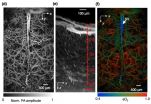(Press-News.org) Researchers studying cancer and other invasive diseases rely on high-resolution imaging to see tumors and other activity deep within the body's tissues. Using a new high-speed, high-resolution imaging method, Lihong Wang, PhD, and his team at Washington University in St. Louis were able to see blood flow, blood oxygenation, oxygen metabolism and other functions inside a living mouse brain at faster rates than ever before.
Using photoacoustic microscopy (PAM), a single-wavelength, pulse-width-based technique developed in his lab, Wang, the Gene K. Beare Professor of Biomedical Engineering in the School of Engineering & Applied Science, was able to take images of blood oxygenation 50 times faster than their previous results using fast-scanning PAM; 100 times faster than their acoustic-resolution system; and more than 500 times faster than phosphorescence-lifetime-based two-photon microscopy (TPM).
The results are published March 30 in Nature Methods advanced online publication.
Other existing methods, including functional MRI (fMRI), TPM and wide-field optical microscopy, have provided information about the structure, blood oxygenation and flow dynamics of the mouse brain. However, those methods have speed and resolution limits, Wang says.
To make up for these limitations, Wang and his lab implemented fast-functional PAM, which allowed them to get high-resolution, high-speed images of a living mouse brain through an intact skull. This method achieved a lateral spatial resolution of five times finer than the lab's previous fast-scanning system; 25 times finer than its previous acoustic-resolution system; and more than 35 times finer than ultrasound-array-based photoacoustic computed tomography.
Most importantly, PAM allowed 3-D blood oxygenation imaging with capillary-level resolution at a one-dimensional imaging rate of 100 kHz, or 10 microseconds.
"Using this new single-wavelength, pulse-width-based method, PAM is capable of high-speed imaging of the oxygen saturation of hemoglobin," Wang said. "In addition, we were able to map the mouse brain oxygenation vessel by vessel using this method."
"Much of what we have learned about human brain function in the past decade has been based on observing changes in blood flow using functional MRI," said Richard Conroy, PhD, program director for Optical Imaging at the National Institute of Biomedical Imaging and Bioengineering. "Wang's work dramatically increases both the spatial and temporal resolution of photoacoustic imaging, which now has the potential to reveal blood flow dynamics and oxygen metabolism at the level of individual cells. In the future, photoacoustic imaging could serve as an important complement to fMRI, leading to critical insights into brain function and disease development."
Concerned about the effects of the microscopy method on the living tissue, Wang and his team found that all red blood cells that were imaged were intact, and there was no damage to brain tissue.
"PAM is exquisitely sensitive to hemoglobin in the blood and to its color change due to oxygen binding," Wang said. "Without injecting any exogenous contrast agent, PAM allows us to quantify vessel by vessel all of the vital parameters about hemoglobin and to even compute the metabolic rate of oxygen. Given the importance of oxygen metabolism in basic biology and diseases such as diabetes and cancer, PAM is expected to find broad applications."
INFORMATION:
Yao J, Wang L, Yang J-M, Maslov K, Wong T, Li L, Huang C-H, Zou J, Wang LV. High-speed Label-free Functional Photoacoustic Microscopy of Mouse Brain in Action. Nature Methods. Published in advanced online publication March 30, 2015, doi: 10.1038/nmeth.3336.
Funding for this research was provided by the National Institutes of Health (DP1 EB016986, R01 CA186567, R01 CA159959) and the National Science Foundation (CMMI-1131758).
The School of Engineering & Applied Science at Washington University in St. Louis focuses intellectual efforts through a new convergence paradigm and builds on strengths, particularly as applied to medicine and health, energy and environment, entrepreneurship and security. With 91 tenured/tenure-track and 40 additional full-time faculty, 1,300 undergraduate students, more than 900 graduate students and more than 23,000 alumni, we are working to leverage our partnerships with academic and industry partners -- across disciplines and across the world -- to contribute to solving the greatest global challenges of the 21st century.
DENVER - Low pre-surgery uptake of a labeled glucose analogue, a marker of metabolic activity, in the primary tumor of patients with stage I non-small cell lung cancer (NSCLC) is associated with increased overall survival and a longer time before tumor recurrence. Patients with high labeled glucose uptake may benefit from additional therapy following surgery.
Surgery is the standard of care for patients with stage I NSCLC but not all patients are cured, as demonstrated by a 5-year survival rate of less than 60% in these patients. There is a clear need for a diagnostic ...
DETROIT - A "perverse disincentive" for hospitals that have invested in expensive technology for robotic surgery may be jeopardizing prostate cancer patients who seek out the procedure, concluded a new study led by Henry Ford Hospital researchers.
The study, which compared complication rates in hospitals with low volumes of robot-assisted radical prostatectomies (RARPs) to institutions with high volumes of the procedure, suggested that current pay-for-performance healthcare models are to blame.
The new study was published online this month by BJU International.
"Patients ...
March 30, 2015 - In women undergoing breast augmentation, a technique using transplantation of a small amount of the patient's own fat cells can produce better cosmetic outcomes, reports a study in the April issue of Plastic and Reconstructive Surgery®, the official medical journal of the American Society of Plastic Surgeons (ASPS).
In particular, the fat grafting technique can achieve a more natural-appearing cleavage--avoiding the "separated breasts" appearance that can occur after breast augmentation, according to the report by Dr. Francisco G. Bravo of Clinica ...
Researchers have shown that a known antibiotic and antifungal compound produced by a soil microbe can inhibit another species of microbe from forming biofilms--microbial mats that frequently are medically harmful--without killing that microbe. The findings may apply to other microbial species, and can herald a plethora of scientific and societal benefits. The research is published online ahead of print on March 30, 2015, in the Journal of Bacteriology, a publication of the American Society for Microbiology. The study will be printed in a special section of the journal ...
From smartphones and tablets to computer monitors and interactive TV screens, electronic displays are everywhere. As the demand for instant, constant communication grows, so too does the urgency for more convenient portable devices -- especially devices, like computer displays, that can be easily rolled up and put away, rather than requiring a flat surface for storage and transportation.
A new Tel Aviv University study, published recently in Nature Nanotechnology, suggests that a novel DNA-peptide structure can be used to produce thin, transparent, and flexible screens. ...
(TORONTO, Canada - March 30, 2015) - Biomedical researchers led by Dr. Gang Zheng at Princess Margaret Cancer Centre have successfully converted microbubble technology already used in diagnostic imaging into nanoparticles that stay trapped in tumours to potentially deliver targeted, therapeutic payloads.
The discovery, published online today in Nature Nanotechnology, details how Dr. Zheng and his research team created a new type of microbubble using a compound called porphyrin - a naturally occurring pigment in nature that harvests light.
In the lab in pre-clinical ...
Maternal diet during pregnancy and lactation may prime offspring for weight gain and obesity later in life, according to Penn State College of Medicine researchers, who looked at rats whose mothers consumed a high-fat diet and found that the offsprings' feeding controls and feelings of fullness did not function normally.
Previous research shows that obesity compromises the neurocircuits that control how the stomach and intestine work to regulate how much we eat, and that the time around pregnancy and lactation is important in the development of these circuits. In both ...
A new study shows that workplace wellness programs can be effective in helping people lose weight by providing healthier food choices and increasing opportunities for physical activity, particularly if these efforts are designed with the input and active participation of employees. The two-year project - the results of which appear in the American Journal of Public Health - successfully reduced the number or people considered overweight or obese by almost 9 percent.
"Worksites are self-contained environments with established communication systems where interventions ...
In computer-science classes, homework assignments consist of writing programs. It's easy to create automated tests that determine whether a given program yields the right outputs to a series of inputs. But those tests say nothing about whether the program code is clear or confusing, whether it includes unnecessary computation, and whether it meets the terms of the assignment.
Professors and teaching assistants review students' code to try to flag obvious mistakes, but even in undergraduate lecture courses, they usually don't have time for exhaustive analysis. And that ...
Boulder, Colo., USA - Scott W. Anderson and colleagues use repeat aerial LiDAR to quantify the erosional impact of the heavy rains that inundated the Colorado Front Range in September 2013. The five-day storm triggered more than 1,100 landslides and debris flows in a 3,430-square-kilometer area due to 200-450 mm of heavy, steady rainfall. This number of hillslope failures in a single event represents unprecedented activity for the region in its ~150 years of written history.
This study for Geology addresses the role of such large, rare events in shaping landscapes by ...

